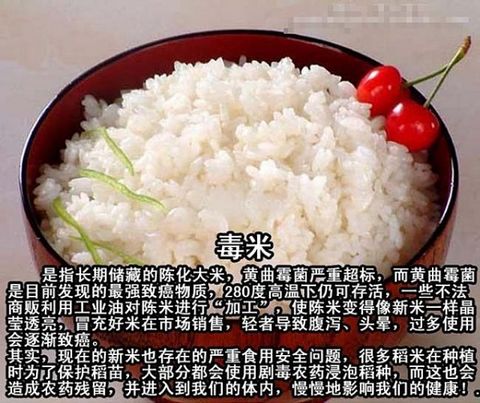“Poison rice”的版本间的差异
来自China Digital Space
| 第6行: | 第6行: | ||
In May of 2013 the term was widely used by netizens in the wake of a [http://chinadigitaltimes.net/2013/05/cadmium-rice-chinas-latest-food-scandal/ scare over rice that had been tainted with the toxic heavy metal cadmium]. | In May of 2013 the term was widely used by netizens in the wake of a [http://chinadigitaltimes.net/2013/05/cadmium-rice-chinas-latest-food-scandal/ scare over rice that had been tainted with the toxic heavy metal cadmium]. | ||
| − | <feed url="feed://chinadigitaltimes.net/china/food- | + | <feed url="feed://chinadigitaltimes.net/china/food-scandal/" entries="5"> |
== [{PERMALINK} {TITLE}] == | == [{PERMALINK} {TITLE}] == | ||
'''{DATE}, by {AUTHOR}''' | '''{DATE}, by {AUTHOR}''' | ||
2013年9月16日 (一) 20:50的版本
毒大米 (dú dà mǐ): poison rice
“Poison rice” is rice that has been treated to increase its marketability. Old rice (陈米 chén mǐ, rice that has been stored for over a year) is polished, treated with chemicals, and coated with paraffin. This gives the rice a desirable translucent appearance. Unfortunately, the treated rice causes negative health effects. For more on this topic, please read Netizen: List of Toxic Foods You Need to Know.
In May of 2013 the term was widely used by netizens in the wake of a scare over rice that had been tainted with the toxic heavy metal cadmium.
<feed url="feed://chinadigitaltimes.net/china/food-scandal/" entries="5">
[{PERMALINK} {TITLE}]
{DATE}, by {AUTHOR} </feed>





